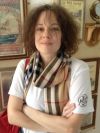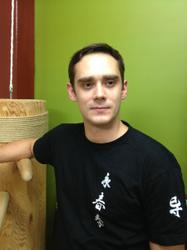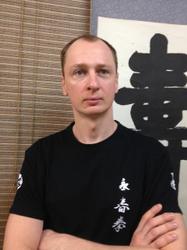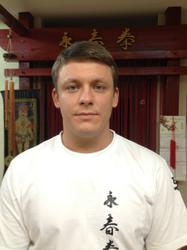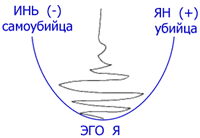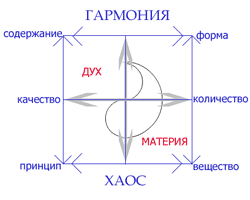Our School’s Traditions
The traditions of our Yun Chun Quan (Wing Chun) school are based upon the great teachings of Buddha, Lao-Tzu and Confucius; they absorbed the best of Western philosophy, medicine, psychology, astronomy, as well as Art from India, China, Tibet and Vietnam. Of course it is not possible to gain all of this knowledge simply by reading books, watching films or observing pupils and Masters of Wing Chun at their classes. Only by following the path of deep practical immersion into the world of the mysterious and magnificent Art, by following the path step by step (every day, every moment, in life and at classes) can such knowledge be accessed. One must feel’ the fullness of the school and its teachings.
The Yun Chun Quan Master is first and foremost a human. Just like the average person, he can be either happy or sad. Masters can also become sick, get old and die. However, they always follow the path of self-perfection, choosing the Middle (Golden) Way. They know what they can achieve. They can recount experiences and aim at the light of truth, kindness and fairness. The most distinctive characteristic of a real Master is the ability to see shape and content; to hear not only words but their meanings; and to be always here and now’. This explains why they can understand the past and the future in a single moment of time.
Meeting such a teacher, therefore, is not easy. You have to be ready ethically. You must be morally open in order to communicate with your internal world rather than to aim at attaining shallow-based knowledge. Just like any serious deep knowledge, Yun Chun Quan is boundary-less in form, but different from others in its rules and principles.
This is why all martial arts seem somewhat similar, at least from an internal perspective. When viewed with extra special attention, even the individual leaves of a single tree can be shown to differ.
No doubt the Yun Chun Quan Art has absorbed thousands of years’ experience of martial arts development in terms of Indian, Chinese, and other traditions. Our Yun Chun Quan school does not divide the internal and external systems the way they are divided in China. As we have already remarked, the school includes the study of traditions, medicine, psychology, martial technique and internal work, which comprises physical exercises and breathing (Qigong), and the static- and dynamic meditation techniques.
One mandatory condition is the study of Buddhism and Taoism. (We do not speak about nature and correlate it with religion. Natural knowledge and fundamental environment). The world of the student or a person following the path’ undergoes a re-evaluation in all areas of social norms, in the society he grew up in. This doesn’t mean that everything has to be changed inside out’. Traditions and religions are often in dispute with one another and have been for all people for thousands of years. But, in reality, a fair rule exists: the principle of addition exists in the world. So, in our school, we implant an understanding, a co-ordination and an acceptance of all that seems strange at first sight, against established beliefs. This understanding is being instilled in the student’s mind. Our school’s aims are spiritual. This school is like a family: the relations are not blood’ relations but, rather, spiritual. Spirit and matter exist as one whole entity. This must be clear to perfect oneself as a person.
The School has its own emblem. It maintains its principles. Change only takes place with time, just like any existing tradition which, along the way, absorbs new knowledge, taking into consideration language and the style of the time. This very special five-petal plum’ flower is both Spring and person: sight, hearing, smell, touch and taste. The circle encapsulating the flower symbolises both wholeness’ and the closed nature of macro- and micro-space, viewed in a single moment. The Yin-Yan’ of the masculine and feminine form is the single whole unity of two opposites. The woman’s passive nature is indicated by the colour black whereas active man’s by white. A change in the Yin and Yan elements is a necessary principle in the central line in battle control and the middle way of life. This is a condition for development in life and a principle of battle conduct. This shows, then, an understanding of the interaction of space and time’, of motion and strength’ and life and death’.
|
YIN (-) YAN (+) He who commits suicide He who is a killer
EGO ME |
The Taost illustration shows the advantages of the middle way.
Whilst developing Yin-Yan thoughts, ideas and actions a person may follow the path of tyranny and even become a killer. The individual who constantly develops Yin-Yan principles may, after increasingly deep introspection and self-analysis, become swayed towards suicide.
You can think for yourself and actually add to the list below. You will see that as you move down the list, you aim up. Do not forget about speed when developing strength. Relaxation combines with exertion and so on.
YIN - YAN
Moon - Sun
Matter - Spirit
Strength - Energy
Nutrition - Breath
Breathe - out Breathe in
Relaxation - Exertion
Cowardice - Bravery
Ignorance - Knowledge
Internal - External
Soft - Hard
Down - Up
Strength - Speed
Static - Dynamic
Defence - Attack
Technique - Tactics
Form - Content
Defeat - Victory
In battle the material mixes with the spirit. Battle involves ethic and tests the person’s spirituality, achieving particular psycho-physical conditions. The higher the level of Mastership, the higher must be the level of human qualities. It is not possible to achieve the highest Mastership without raising your human qualities.
A teacher says: “Every day we come across fire. We lose years in trying to comprehend its nature. Every day we ponder the nature of water and also lose decades. There’s no need to talk about how much we lose in trying to comprehend the interaction of fire and water’ together. Similarly, we aim to break through the rubbish and experiences of the mind on a daily basis. We spend our lives doing this. We leave the house to fight external enemies and then return home to our own.”
A comprehension of the internal meaning of Yun Chun Quan requires a particular immersion into the metaphysical arena and into an area of the non-perceptible, the incomprehensible. The teacher says: “Emptiness is nothing. Emptiness of the emptiness is nothing.” What does the pupil understand at this moment?
What do we really know and understand? Try to ask yourself this question seriously. For example, why or what do I see? What does it all really mean? Why is the glass clear? And where does the fire go when the candle is extinguished? Only programmed answers along with memories of them appear as logical thoughts about these questions. In reality, though, we know or understand nothing! We only re-tell each other the same information, recited from own logical interpretation.
A teacher stretches his hand to a student and asks the question: “what it is?” The student answers with certainty: “it’s a hand”. The teacher retorts: “I didn’t ask what it is called!” What did the teacher mean by this?
Perhaps questions and answers reveal their different levels: not only are memories needed, but also a presence in the here and now’. You might say: “..but progress and science develop so quickly, especially nowadays”. In my youth I wanted to see how a car factory worked. I was shocked by the result: 99% of people wondering around the workshop, practically without purpose. Despite this impression, a new car was leaving a production line every minute! This is not metaphysics, this is magic!
Does all of this relate specifically to martial arts and Wing Chun? Yes and No! Yes, because having touched something’ we can not also touch everything’ at the same time. And No, because we do not know and do not understand that which is happening around us.
| HARMONY content form CHAOS |
The interrelation of spirit and matter in the Universe (straight lines in the illustration show the Yin-Yan relationship between the elements). The teacher says: “Chaos of matter delivers a substance. Chaos of spirit delivers principle. Substance develops quality. Principles of chaos deliver quality. Quantity of substance delivers a form. Quality of principle is content. Form of quantity establishes material order in our Universe. A content of quality expresses spiritual order in the Universe”. That is an example of the unquestionable logical concept of understanding the world. But who knows what stands behind these precise explanations? How many lives and ambitions need to be understood? Many of those who speak of the sublime and engage in Eastern philosophical thinking, thumb quickly through the pages full of similar phrases. They read further and further…
At our Wing Chun site we will introduce you to the many wise and enlightening thoughts of our Wing Chun teachers as well as an insight into their spirituality and martial arts philosophy.
But do not be in such a hurry to flip through the information! Feedback is very important. Communicate with each other and with us. Meditate and then a great deal will become clear.



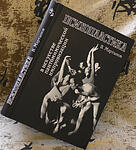

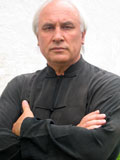 Коан – вопрос к членам Федерации Юн Чун Цюань от президента В.В. Мартынова: «Что Вы сделали для Федерации из того, что не мог бы сделать любой другой за деньги?»
Коан – вопрос к членам Федерации Юн Чун Цюань от президента В.В. Мартынова: «Что Вы сделали для Федерации из того, что не мог бы сделать любой другой за деньги?»